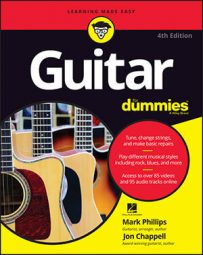Slide guitar is an important addition to blues-guitar technique. In playing slide, you don't use your left hand to fret the guitar by pressing the strings to the fretboard, as you normally do. Instead, you hold a metal or glass bar (the slide) over the neck and stop (shorten the vibrating length) the strings by pressing the slide lightly against the strings at a given fret.
To play in tune, you must position the slide directly over the fret wire itself, not behind it as you do in normal fretting.
For the slides themselves, you can use anything from the neck of a wine bottle to a medicine bottle (the cough medicine Corrocidin made the ideal vessel and was a favorite of Duane Allman's) to a small length of brass pipe. The back edge of a knife works in a pinch, too. Today, specially made glass and brass slides, available in music stores, come in various diameters to accommodate different finger sizes.
Most people usually wear the slide on the ring finger or pinkie, which leaves the other fingers free for fretting. The slide material itself determines the weight and tone, and whether you choose a heavier or lighter slide is a subjective matter.
Because the slide lays across the strings in a straight line, playing chords where the notes are on different frets becomes rather difficult. Many guitarists solve this problem by tuning the guitar to an open tuning, such as G or D. Many slide-blues greats used (or still use) open tunings. Robert Johnson played in open G; Duane Allman played in open D or E; Bonnie Raitt plays in open A; and Derek Trucks plays in open E.
The quality of lead guitar becomes sustained, expressive, and vocal-like if you play with a slide. Because the slide rides on top of the strings and doesn't use the frets for its pitches, the response is more like that of a violin or a voice, where the pitch change is smooth and continuous as opposed to the more "detached" sound that results from normal fretting. As you listen to the great slide artists, listen especially to their phrasing. That's the best way to appreciate slide guitar's emotional power — in the expressive execution of the melodic line.

